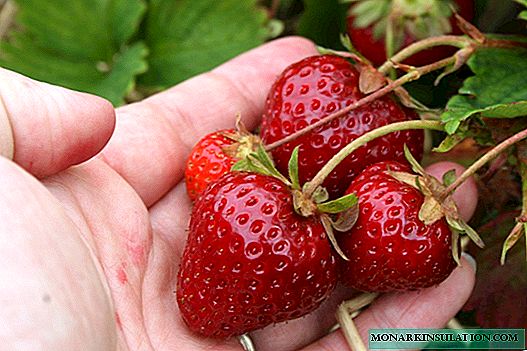
Every person needs to eat grapes, as these berries are not only tasty, but also very useful. If you want to grow grapes yourself, you should carefully study the characteristics of various varieties. For lovers of grape "classics", you can recommend the Californian table variety of dark grapes Cardinal, which gives very early harvests.
The history of the cultivation of Cardinal grapes
Variety Cardinal appeared a long time ago - in the middle of the last century. Bred by California breeders E. Snyder and F. Harmon on the basis of crossing varieties of the Queen of the vineyards and Alfons Lavalle. The new variety gradually spread to Italy, Yugoslavia, Greece, France and other European countries.
In 1958, the Cardinal was brought to Soviet Russia from France (Montpellier Nursery), since 1965 he began to pass the state variety test, and since 1974 the variety was officially registered in the State Register of Selection Achievements. Zoned in the North Caucasus region, and since 2004 - in the Lower Volga region.
Grapes Cardinal and its varieties in the photo

- Anapa Cardinal obtained by Russian breeders and has a higher frost resistance

- Cardinal berries are covered with a characteristic smoky wax coating

- Cardinal resistant differs from its “parent” in great immunity to diseases
The cardinal became the basis of many other grape varieties. In particular, there are Anapa Cardinal varieties obtained in Russia, and the Moldovan Cardinal stable, obtained by crossing the Cardinal with Moldavian grapes Criuleni.
Description of the variety Cardinal
Cardinal is a table variety with a very early ripening period - 105-110 days elapse from the beginning of the growing season to the maturation of the first brushes.
The bushes are notable for their high growth force, reaching a height of 3 m. The yield of the variety can be very high, since up to 70 fruiting shoots are formed on each plant, on average 1-2 brushes are formed on each of them. The vines ripen 1/2 to 2/3 of the length. The greens are dense, the leaves are large, shiny, without pubescence, with triangular teeth along the edge. The flowers are self-pollinating.
Bunches of cylindrical-conical shape (sometimes with a wing), rather large, but loose. It is because of the looseness of the brush with a length of 25-30 cm has a mass of 300-600 g.

Cardinal has large rounded berries.
The oval or round-oval berries are quite large (weight 5-7 g). A distinctive feature of berries is grooves on the surface. The dense skin is painted dark red-violet with a smoky wax coating. The color of the juicy, slightly crisp pulp is greenish-white. 3-4 seeds are hidden in the pulp. The berries taste very pleasant, sour-sweet, with a light muscat aroma. The sugar content in the berries is not too high - 16-18%, the amount of acid reaches 7-8 g / l.
Grapes Cardinal on video
Variety Characteristics
The Cardinal variety has both advantages and disadvantages.
Advantages:
- early ripening;
- high productivity (up to 20-25 kg from 1 bush);
- can be stored for a long time without loss of quality;
- drought tolerance;
- pleasant taste.
Disadvantages:
- poorly tolerates a drop in temperature during the growing season (shedding of ovary and flowers may occur, the berries are smaller);
- productivity is unstable;
- non-simultaneous ripening of berries in clusters;
- poor winter hardiness;
- poor resistance to diseases and pests;
- exactingness to soil quality and leaving (productivity can fluctuate).
Features of planting and growing
The quality of the future crop is largely determined by a competent planting.
When choosing a place for the Cardinal, you need to keep in mind that he is very sensitive to the cold. Therefore, it should highlight a well-warmed area, sheltered from cold winds. The most suitable soils for this variety are chernozems or loams.
Methods of propagation of grapes
The best way to propagate the Cardinal variety is by grafting the cuttings on an adult stock, best of all on Shasla X Berlandieri or Berlandieri X Riparia bushes, which are resistant to adverse conditions. Cuttings need to be carefully prepared. Usually they are harvested in the fall, during the pruning of vines for the winter. It is advisable to take the stem from the middle part of the fruit shoot with a diameter of 7-10 mm, with an internode length of about 8 cm. Leaves, lateral shoots, apex are removed from the stem. There should be at least 4 kidneys. Since cuttings should be preserved until spring, it is recommended to cover the cut with paraffin and fold the cuttings on the lower shelf of the refrigerator.

To protect the cut during storage, cuttings need to be dipped in melted paraffin
The best time for vaccination is spring, from the last decade of April to the first of May.
The old rootstock bush is removed, leaving a small stump. The surface of the stump is cleaned to full smoothness. The stock should be chopped exactly in the middle, carefully, using a sharp hatchet and a hammer. In the split place the lower part of the handle, cut at an angle from two sides.

The vaccination site should be pulled as tight as possible
The stock should be pulled very tightly and tied with a strip of strong fabric and coated with clay. The grafted bush is watered with 3-4 buckets of water and mulch the soil around the bush with peat or sawdust.
Vaccination of grapes in shtamb - video
A less reliable way to plant the Cardinal is to plant cuttings. Cuttings should be healthy, strong. The number of eyes should be at least 2-3. Cuttings can be sprouted in advance in water until the roots appear. It is useful to dip them into a growth stimulator (sodium humate) before planting. Cuttings are planted in pre-prepared soil, fertilized with potassium-phosphorus preparations and organics. The disadvantage of this method is the need for temperature control. Soil temperature should be at least +10 aboutC, and air - not less than +15 aboutC, otherwise the cuttings simply will not take root.

To form the roots, the cuttings are immersed in water
Grape Care Rules
Cardinal productivity is very dependent on the quality of care. Under unfavorable growing conditions, color and ovary decay, and peeling of berries begin.
The variety is very fond of moisture despite its drought tolerance. Soil moisture should be moderate, but constant: with excess moisture, the berries crack and rot. In the presence of stagnant water, it is necessary to organize drainage. Under normal soil conditions, grapes need to be watered 3-4 times per season. Moisture is especially necessary for bushes during budding and during ovary formation. Under each bush, it is necessary to pour 1-2 buckets of water, preferably warm.
To preserve moisture in the soil, it is recommended to close the trunk circle with mulch from mowed grass or sawdust.

Mulching the soil with straw will help maintain moisture in the soil
Vine bushes need pruning. In the warm southern regions, you can grow the Cardinal variety in the form of a tree with a high stem - in this case, the grapes give high yields, and the clusters differ in size and elegant appearance.
In cold regions, bushes are usually formed in the form of a fan or a two-shouldered cordon.
To obtain a cordon, two main vines are formed on the vine bush, which are sent horizontally in different directions along the trellis. On the main vines, all shoots are removed, except for vertical ones, which are placed at regular intervals and fixed on the trellis.
Diagram of the formation of grapes in the form of a two-shouldered cordon - video
When fan pruning on the bush, no more than 13-14 fruit shoots should be left, and the total number of eyes should be 25-30. In the first year, the standard part is laid, in the second - 4 or more "sleeves" (skeletal branches) are formed, on which fruit shoots are laid at the beginning of the third year.

Fan formation takes 3 years
In addition to watering and pruning, the Cardinal needs regular top dressing. Organics in the form of compost or humus are introduced in spring and autumn by mulching the bushes with a thick (5-8 cm) layer of fertilizer.
In addition to organics, it is necessary to feed grapes with minerals (you can use complex fertilizer). This is done 3-4 times during the growing season: when the leaves appear, before the buds open, after the color falls off and after the harvest.
Spraying with a solution of iron sulfate helps to eradicate one of the disadvantages of the variety - the non-simultaneous ripening of berries.
Since the Cardinal is unstable to diseases, it is necessary to carry out preventive treatments in a timely manner. Since Cardinal mainly suffers from fungal diseases, the vine is treated mainly with fungicides. Preparations such as colloidal sulfur or Ridomil are dissolved in water and sprayed on plants, trying to spray both the upper and lower surfaces of the leaves, as well as the bark of the shoots.
Protecting grapes from diseases and pests - video
The main pests of grapes are wasps and birds. And from those, and from others, you can protect yourself by tying each brush into a bag of gauze or thin tissue. Of course, this method requires a lot of time and labor, but protection is guaranteed.
In winter, Cardinal bushes must be covered (except in the southern regions). To do this, after the autumn pruning, the vines are bundled and bent to the ground, and then tied with straw or covered with a film or soil.

A vine wrapped in film can be sprinkled on the sides with earth and crushed with stones for better preservation.
Harvesting, storage and use of crops
You can start harvesting Cardinal grapes in the first half of August. The brushes are cut with a secateurs, leaving a leg 4-5 cm. For transportation, shallow baskets or wooden boxes are best suited, in which it is desirable to put the grapes tightly.
The Cardinal is stored for a rather long time - about 3 months in a cool room with constant humidity.
Despite the table's purpose, it can be used to make raisins, juice, compotes, and preserves.

From grapes you can cook a delicious compote
Gardeners reviews
My Cardinal, medium-sized, grows on loam, acquired in the Botanical Garden in 2006, does not create problems with diseases with 2-3 treatments, the berries are large, but, of course, not the Talisman, clusters are large - 0.8-1.2 kg. The largest bunch of my varieties grew just on the Cardinal - 2.2 kg. The taste is wonderful, the aroma is extraordinary. When will ripen. And it matures in late September or early October. I try not to overload. According to some local reviews, a shift in the ripening period is a typical picture of the behavior of a variety in Saratov.
Vic, Saratov//forum.vinograd.info/showthread.php?p=569720
this year, the Cardinal variety did not ripen early, it was edible already at the end of July. It usually ripens in the first ten days of August, at this time everything with it is both kind and taste.
pioneer 2//forum.vinograd.info/showthread.php?p=569720
And my Cardinal doesn’t get sick, despite the fact that there is a squeamish BCR growing nearby and their vines sometimes grow intermittently, but the Cardinal does not become infected from it (though it was treated 2 times during the summer for prevention). The growth is very powerful 4-5 m and the ripening is good .A taste is just a miracle, with nutmeg and some floral and fruity notes (I can’t describe exactly). In general, it’s very rich in taste, I didn’t lie close with the imported Cardinal, although the clusters are not so beautiful and smaller. Yes, I’m especially not chasing huge clusters. I grow grapes for myself and my relatives. I also noticed that the taste became noticeably richer with the growth of perennial wood. I plan to remove the next squeamish BSR and extend the vine to its place on the trellis. I cover it with earth every year. Now there are frosts under 20 degrees. without snow, no matter how frozen, the layer of earth is not thick.
Kalinovka//forum.vinograd.info/archive/index.php?t-1846-p-2.html
Kardinal grape variety. You can say classic. We grow, really like
pioneer 2//lozavrn.ru/index.php?topic=359.0
Grapes Cardinal - not the easiest variety to grow. However, if you are ready to spend time caring for it and protecting it from diseases and pests, this classic variety will delight you with an abundant harvest of large juicy berries with a nutmeg aroma. By taste, many experts call this variety a luxury grape.














